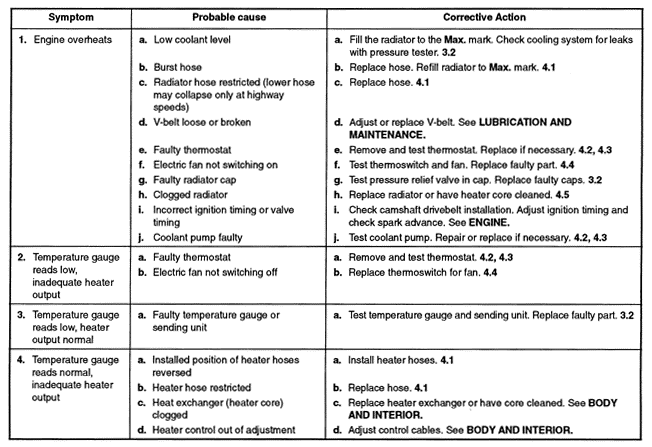3.1 Basic Troubleshooting PrinciplesWhen investigating the cause of overheating or coolant loss, begin with a visual inspection of the system. Check coolant level and for evidence of coolant leaks. Leaks can occur at any place in the cooling system where there is a bolted housing or other connection. An occasional drop of coolant found under the coolant pump is normal, and is not cause for concern. The system becomes pressurized at normal operating temperatures, and this pressure is important to system function. Leaks may prevent the system from becoming pressurized and allow the coolant to boil at a lower temperature. If visual evidence is inconclusive, a cooling system pressure test will determine whether the system leaks, and may help to indicate the source. See 3.2 Diagnostic Tests. If the cooling system is full of coolant and holds pressure, the next most probable cause of overheating is bad coolant circulation caused by a broken V-belt, a failed thermostat, a pinched or restricted hose, or a clogged system. In warm weather, virtually all clogs are caused by neglect of the coolant, or by the addition of substances to the coolant that are not recommended by Volkswagen. In cold weather, a clogged cooling system may also be the result of frozen coolant due to an inadequate amount of anti-freeze. The engine-driven coolant pump is subject to the same wear as any other rotating engine parts. Complete failure of the pump to circulate coolant is unusual, but excessive wear often results in noise or coolant leaks at the pump shaft. An otherwise sound cooling system may still have overheating problems, particularly with prolonged idling, if the radiator cooling fan is inoperative. The cooling fan should cycle on and off whenever the coolant temperature is above normal. If the fan does not cycle, test the fan as described in 4.4 Radiator Cooling Fan. Table a. Cooling System Troubleshooting
Table a lists overheating and underheating symptoms, their probable causes, and suggested corrective actions. The bold numbers in the corrective action column refer to headings in this section where the suggested repairs are described. |
